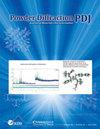盐酸布替萘芬C23H28NCl的晶体结构
IF 0.4
4区 材料科学
Q4 MATERIALS SCIENCE, CHARACTERIZATION & TESTING
引用次数: 0
摘要
利用同步加速器X射线粉末衍射数据对盐酸布替萘芬的晶体结构进行了求解和细化,并利用密度泛函理论技术对其进行了优化。盐酸丁那芬在空间群P21(#4)中结晶,a=13.94807(5),b=9.10722(2),c=16.46676(6)Å,β=93.9663(5)°,V=2086.733(8)Å3,Z=4。盐酸丁那芬是阳离子的R和S对映体的外消旋共晶。晶体结构的特征是沿着b轴平行堆叠的芳香环。每个阳离子形成一个强大的离散N–H·Cl氢键。氯阴离子还充当来自亚甲基、甲基和芳香基团的几个C–H·Cl氢键的受体。粉末图案已提交给ICDD,以纳入粉末衍射文件™ (PDF®)。本文章由计算机程序翻译,如有差异,请以英文原文为准。
Crystal structure of butenafine hydrochloride, C23H28NCl
The crystal structure of butenafine hydrochloride has been solved and refined using synchrotron X-ray powder diffraction data, and optimized using density functional theory techniques. Butenafine hydrochloride crystallizes in space group P21 (#4) with a = 13.94807(5), b = 9.10722(2), c = 16.46676(6) Å, β = 93.9663(5)°, V = 2086.733(8) Å3, and Z = 4. Butenafine hydrochloride occurs as a racemic co-crystal of R and S enantiomers of the cation. The crystal structure is characterized by parallel stacks of aromatic rings along the b-axis. Each cation forms a strong discrete N–H⋯Cl hydrogen bond. The chloride anions also act as acceptors in several C–H⋯Cl hydrogen bonds from methylene, methyl, and aromatic groups. The powder pattern has been submitted to ICDD for inclusion in the Powder Diffraction File™ (PDF®).
求助全文
通过发布文献求助,成功后即可免费获取论文全文。
去求助
来源期刊

Powder Diffraction
工程技术-材料科学:表征与测试
CiteScore
0.90
自引率
0.00%
发文量
50
审稿时长
>12 weeks
期刊介绍:
Powder Diffraction is a quarterly journal publishing articles, both experimental and theoretical, on the use of powder diffraction and related techniques for the characterization of crystalline materials. It is published by Cambridge University Press (CUP) for the International Centre for Diffraction Data (ICDD).
 求助内容:
求助内容: 应助结果提醒方式:
应助结果提醒方式:


